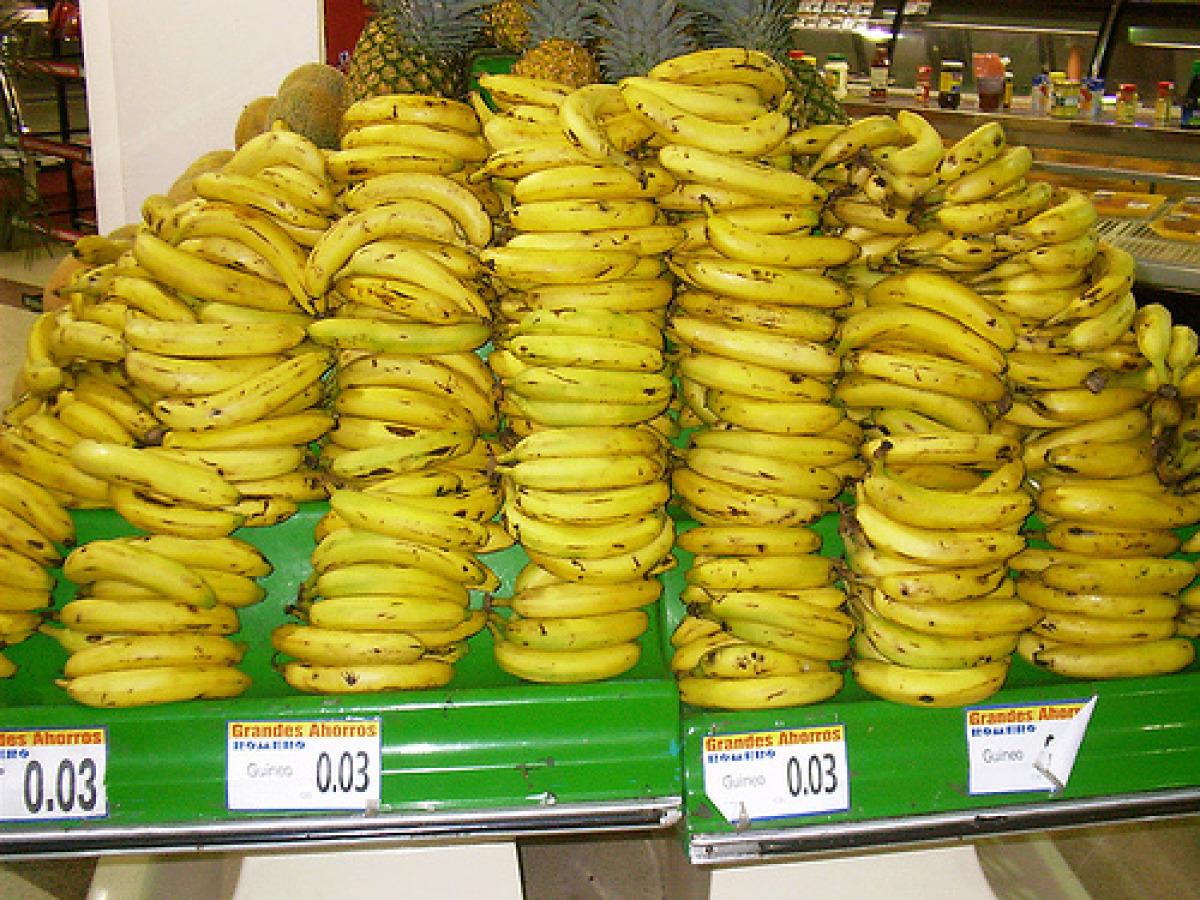What do people eat in Panama?
Diet
Because Panama is an international crossroads, a variety of cuisines are available. French, Spanish and American food is available in all restaurants and hotels in Panama City. Native cooking is similar to Creole Cuisine, Hot and spicy. Dishes include ceviche (fish marinated in lime juice, onions and peppers) Patacones de platano (fried plantain) sancocho (Panamanian stew with chicken, meat and vegetables) tamales (seasoned pie wrapped in banana leaves or corn husks) and carimanolas and empanadas (turnovers filled with meat, chicken or cheese) Panamanians have arroz (ah-ROHS) or rice with most of their meals. The eat the rice either plain or add meat and vegetables to eat. They often eat both potatoes and rice at one meal. Panama has an abundance of fish and seafood. Most Panamanians meals also include corn tortillas. Yucca is a commonly served vegetable.Panamanians love to eat out. And Panama City residents have a wide variety of restaurants to choose from. In addition to restaurants a panadera sells take-out bread and rolls, a pastelera(pas-tell-ay-REE-ah) offers pastries and a cantina(kan-TEE-nah) is a drinking establishment. Panamanians tip there servers about 15% of the bill. Panamanins eat three hearty meals per day. El desayuno(day-sigh-noh) breakfast, el almuerzo(ahl-MWER-sho)Lunch and la cena(SAY-nah) dinner.
Mealtime
Most Panamanians eat a great deal of corn, rice and beans. They also eat tortillas, which are flatbreads made from cornmeal. These are filled with meat, beans, and cheese. Black beans are popular in Panama. A popular Panamanian dish is "ceviche". This is made of raw fish or shellfish soaked in lime or lemon juice, olive oil and hot spices. Panamanians like their food spicy. Tamales are made of corn dough. They are filled, wrapped in a banana leaf and steamed.Urban people eat traditional foods as well as a wider variety of international foods. People eat rice with almost every meal. Beans and corn are also common foods. Guacho (GWA-cho) is rice soup with beans. Bollo (BOH-yo) is a boiled corn dish. Tortillas (tor_TEE-yas) also are popular. People make these flatbreads from corn or wheat.
Sancocho (sahn-KHO-cho) is Panama' national dish. People make this stew with spicy vegetables and chicken. Panamanians eat a lot of meat and seafood. Guisado (kwee-SA-doh) is a stew with meat and tomatoes. Panamanians sometimes add fish to soup. Panamanian families usually eat together, they have a big breakfast. The main meal with rice, meat and vegetables is in the middle of the day. Families often eat a small meal in the evening.
The typical breakfast is thick, deep-fried tortillas with white cheese, liver, garlic, and onions, and fresh rolls or bread. A typical lunch begins with soup followed by chicken or steak. Served with cooked rice and red kidney beans or pigeon peas. Salad is eaten with the main course. Dinner consists of meat covered with a spicy sauce, rice and a salad. Dessert is usually fruit. Occasionally they indulge in cake, pie or cheesecake. After dinner they enjoy a cup of coffee. The most popular Panamanian dessert is sopa borracha (SOH-pah-bohr-RAH-chah) which is pound cake topped with syrup, rum or brandy, cinnamon raisins and cloves.
Popular Panama Recipes
- Arroz con Pollo (Chicken and Rice) - Main Dish
- Ceviche De Garbanzos - Main Dish
- Chicha de Arroz con Pina (Fresh Pineapple Drink) - Beverage
- Hojaldres - Dessert
- Plantain Cereal - Main Dish
- Rice with Guandu - Main Dish
- Sancocho (Chicken Soup) - Main Dish
- Tortilla de Maiz con Queso Blanco (Corn Tortilla with Farmer’s Cheese) - Main Dish

World Regions
All Countries
Afghanistan
Akrotiri
Albania
Algeria
American Samoa
Andorra
Angola
Anguilla
Antarctica
Antigua and Barbuda
Argentina
Armenia
Aruba
Australia
Austria
Azerbaijan
Bahamas
Bahrain
Bangladesh
Barbados
Belarus
Belgium
Belize
Benin
Bermuda
Bhutan
Bolivia
Bosnia and Herzegovina
Botswana
Brazil
British Indian Ocean Territory
British Virgin Islands
Brunei
Bulgaria
Burkina Faso
Burma
Burundi
Cabo Verde
Cambodia
Cameroon
Canada
Cayman Islands
Central African Republic
Chad
Chile
China
Christmas Island
Clipperton Island
Cocos (Keeling) Islands
Colombia
Comoros
Congo, Democratic Republic of the
Congo, Republic of the
Cook Islands
Coral Sea Islands
Costa Rica
Cote d’Ivoire
Croatia
Cuba
Curacao
Cyprus
Czech Republic
Denmark
Dhekelia
Djibouti
Dominica
Dominican Republic
Ecuador
Egypt
El Salvador
Equatorial Guinea
Eritrea
Estonia
Eswatini
Ethiopia
Falkland Islands
Faroe Islands
Fiji
Finland
France
French Guiana
French Polynesia
Gabon
Gambia, The
Gaza Strip
Georgia
Germany
Ghana
Gibraltar
Greece
Greenland
Grenada
Guadeloupe
Guam
Guatemala
Guernsey
Guinea
Guinea-Bissau
Guyana
Haiti
Holy See
Honduras
Hong Kong
Hungary
Iceland
India
Indonesia
Iran
Iraq
Ireland
Isle of Man
Israel
Italy
Jamaica
Jan Mayen
Japan
Jersey
Jordan
Kazakhstan
Kenya
Kiribati
Korea, North
Korea, South
Kosovo
Kuwait
Kyrgyzstan
Laos
Latvia
Lebanon
Lesotho
Liberia
Libya
Liechtenstein
Lithuania
Luxembourg
Macau
Madagascar
Malawi
Malaysia
Maldives
Mali
Malta
Marshall Islands
Martinique
Mauritania
Mauritius
Mayotte
Mexico
Micronesia
Moldova
Monaco
Mongolia
Montenegro
Montserrat
Morocco
Mozambique
Namibia
Nauru
Nepal
Netherlands
New Caledonia
New Zealand
Nicaragua
Niger
Nigeria
Niue
Norfolk Island
North Macedonia
Northern Mariana Islands
Norway
Oman
Pakistan
Palau
Panama
Papua New Guinea
Paraguay
Peru
Philippines
Pitcairn Islands
Poland
Portugal
Puerto Rico
Qatar
Reunion
Romania
Russia
Rwanda
Saint Helena, Ascension, and Tristan da Cunha
Saint Kitts and Nevis
Saint Lucia
Saint Pierre and Miquelon
Saint Vincent and the Grenadines
Samoa
San Marino
Sao Tome and Principe
Saudi Arabia
Senegal
Serbia
Seychelles
Sierra Leone
Singapore
Slovakia
Slovenia
Solomon Islands
Somalia
South Africa
Spain
Sri Lanka
Sudan
Sudan, South
Suriname
Svalbard
Sweden
Switzerland
Syria
Taiwan
Tajikistan
Tanzania
Thailand
Timor-Leste
Togo
Tokelau
Tonga
Trinidad and Tobago
Tunisia
Turkey
Turkmenistan
Turks and Caicos Islands
Tuvalu
Uganda
Ukraine
United Arab Emirates
United Kingdom
United States (US)
Uruguay
Uzbekistan
Vanuatu
Venezuela
Vietnam
Virgin Islands
Wake Island
Wallis and Futuna
West Bank
Western Sahara
World
Yemen
Zambia
Zimbabwe
